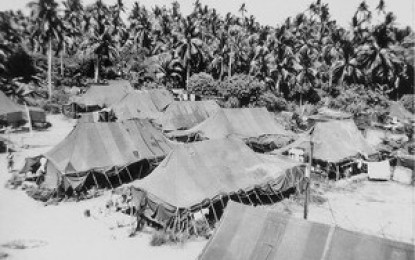
REFUGEE CAMP. The tent camp of 'White Russian' refugees in Tubabao Island, Guiuan, Eastern Samar in this 1950 photo. A local author will pursue further research on the accounts of 'White Russians' who took shelter on the Island 70 years ago. (Photo from Russian Orthodox Church Philippine Mission website)
GUIUAN, Eastern Samar -- A young author will pursue further research on the accounts of "White Russians" who took shelter in this town’s Tubabao Island 70 years ago.
Kinna Mae Kwan said in an interview Tuesday she needs to go to France to get information from the country’s archive to learn more about the "White Russians" during and after their stay in Tubabao Island.
“This is very emotional for me because the refugees especially the old ones told me that they wanted people to know about their experiences in Tubabao,” Kinna told the Philippine News Agency (PNA).
“My goal here is to finish the book before they die. I consider them my grandfathers and grandmothers and they were very kind to me when I was doing research,” she added.
Kwan, the daughter of Guiuan town Mayor Annaliza Gonzales-Kwan, is one the authors of the 283-page book “Memories and Meanings in Tubabao: Assessing the Social Significance of a Refugee Camp in Guiuan, Eastern Samar, 1949-1951”.
She started her research on "White Russians" in Tubabao when she was still in college. She went to Australia through the help of the local government and met with 12 former refugees, who introduced her to other refugees who settled in the United States.
The President Elpidio Quirino Foundation noticed her research in 2015 and funded her travel to the US. The information she gathered was compiled in a book that contains initial data of her ongoing research about White Russians in Tubabao.
She added that aside from writing the book, which will help in educating people about the history of Tubabao and its relationship with Russians around the world, the local government and the Department of Tourism have created a tour package for Russian tourists who will visit Tubabao.
The package is dubbed Dobrota Tur - The White Russians Transit Commemoration Tour, which starts in Tacloban City, then a stop at the Balangiga Bells in Balangiga town before going to Tubabao Island.
Dobrota is a Russian word that means kindness or goodness.
“Some residents in Tubabao are going to be trained in tour guiding and will be taught on information about the Russians' stay on the island based on my research,” Kwan said.
The capacity building of locals is in preparation for the expected influx of Russian pilgrims in February 2020.
Tubabao Island has a significant contribution to Russian history after they welcomed 6,000 Russian refugees who stayed on the island from 1949 to 1951.
The refugees were called “White Russians” who evaded the communist government. It was only the Philippine government, under then-President Elpidio Quirino, which responded to their letter requesting for a temporary shelter.
Tubabao Island, a former US Navy base during World War II, became their temporary home while waiting for the international community to respond to their plea for asylum.
The refugee camp housed professors, engineers, architects, artists, ballerinas, doctors, lawyers, priests, and former officers of the Czar's army. The refugees even held concerts and cultural shows to entertain them while on the island. To earn a living some had taught locals especially children, ballet and piano lessons.
Among the prominent Russian refugees who lived on the island was Michael Borisovitch Maximovitch or Archbishop John of Shanghai whom the Russian Orthodox Church had venerated into sainthood as St. John of Shanghai and San Francisco.
In 1951, after two years of stay on the island, the refugees were granted asylum to the US, Australia, France, South America, and European countries. (PNA)
